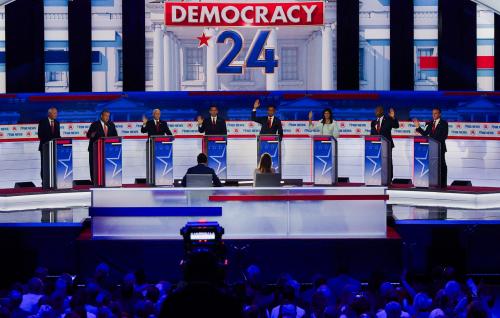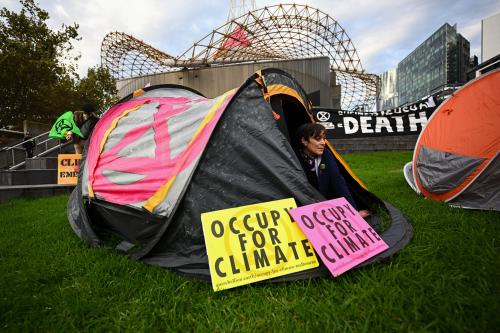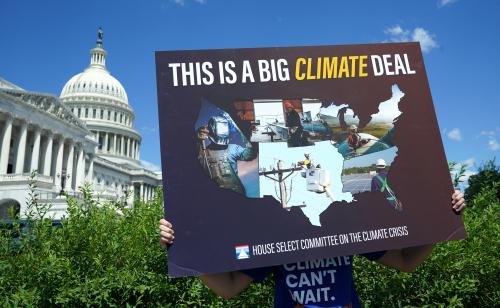Suppose Al Gore had become president and proposed a law to cut pollution from power plants by about 70 percent at a low cost, to discourage the lawsuits that often stall clean-air rules from being enforced, and to serve as a model for a future system to regulate greenhouse gases. Chances are Mr. Gore would have been widely praised. Instead George W. Bush got the White House and announced a plan to do those very things, yet it has been relentlessly denounced by Democrats, environmentalists, editorial pages and even characters in a Doonesbury cartoon.
Critics both real and drawn assert that the program, which is called Clear Skies and is scheduled to be voted on by the Senate Environment and Public Works Committee today, is a shocking assault on clean-air law, an insidious weakening of environmental protections wrapped up with an Orwellian label. These criticisms are off target, except it is true that Clear Skies is a really dumb name.
Mr. Bush’s proposal would cut by more than 70 percent the amounts of sulfur dioxide, nitrogen oxides and mercury emitted by power plants. The first two substances cause acid rain and contribute to respiratory disease; the third is a poison. The plan would also permanently cap plant emissions nationwide, meaning that pollutant levels must not rise no matter how much more power is generated in the future. The proposed cap for sulfur dioxide is 90 percent lower than the amount emitted in 1970; the cap for nitrogen oxide is 94 percent lower than 1970.
So, under the Bush plan – supposedly a sellout to industry – sulfur dioxide and nitrogen oxide, the two power-plant emissions of most concern to public health, would be nearly eliminated as compared with levels in 1970. Clear Skies would also moot the long-running controversy over the “new source review” rule, which may require operators of the old power plants in the Midwest to add pollution controls when those plants are modified. Those plants too would have to participate in the 70 percent overall reduction, a deeper cut than required by any interpretation of the “new source” standard.
Opponents of Clear Skies rightly note that existing Clean Air Act language already mandates somewhat greater reductions than the Bush plan – for instance, a 93 percent cut in sulfur dioxide from the levels in 1970, versus Clear Skies’ 90 percent – and that the reductions must be complete by 2012, rather than by 2018 as in Mr. Bush’s bill. But here’s the rub: the existing Clean Air Act, though successful, is a complex set of rules that requires a case-by-case drawing up of plans for states, localities and even individual power plants. A raft of lawsuits often accompanies every Clean Air Act regulation – it is common for both industry and environmental organizations to sue to block the same set of rules. This is why, on average, it takes about a decade to complete a Clean Air Act rulemaking.
The Clear Skies plan would replace that case-by-case system with a streamlined “cap and trade” approach. This plan simply sets an overall reduction for the power industry as a whole, then leaves it up to companies and plant managers to decide for themselves how to meet the mandates, including by trading permits to one another.
In practice, cap-and-trade systems have proved faster, cheaper and less vulnerable to legal stalling tactics than the “command and control” premise of most of the Clean Air Act. For example, a pilot cap-and-trade system, for sulfur dioxide from coal-fired power plants, was enacted by Congress in 1990. Since then sulfur dioxide emissions have fallen by nearly a third (the reason you hear so little about acid rain these days is that the problem is declining – even though the amount of combustion of coal for electricity has risen.)
A pleasant surprise of that 1990 program was that market forces and lack of litigation rapidly drove down the predicted cost of acid-rain controls. Now Mr. Bush proposes to apply the same cap-and-trade approach to the entire power industry, in the hope that market forces and fewer lawsuits will lead to rapid, relatively inexpensive pollution cuts.
Here is the real beauty of the Clear Skies plan, something that even its backers may not see: many economists believe that the best tool for our next great environmental project, restraining greenhouse gases, will be a cap-and-trade system for carbon dioxide. Should President Bush’s plan prove that the power industry as a whole can be subjected to a sweeping cap-and-trade rule without suffering economic harm or high costs, that would create a powerful case to impose similar regulation on carbon dioxide, too.
Though you’d never know it from the press coverage, the administration’s idea has respectable support – from the National Research Council, which is a wing of the National Academy of Sciences, and from the former Environmental Protection Agency administrator Christie Whitman, who since leaving the administration has become a leading critic of the Republican right.
Yes, as in any lawmaking, there is a legitimate danger that factions in Congress will insert into the Bush bill language that does dilute environmental protection. But the underlying idea of the president’s proposal is sound and deserves support, even from the comics page.



Commentary
Op-edClear Skies, No Lies
February 16, 2005